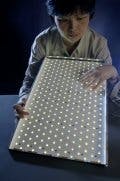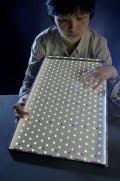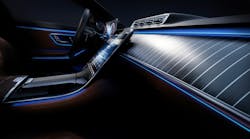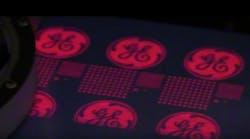Cree's backlighting solution, on show at the Society of Information Displays (SID) meeting in Boston this week, has a power consumption of 40 watts. Cree says that this compares with 100 watts for other LED backlighting solutions and 45 watts for CCFL-based solutions.
The backlight, demonstrated by a prototype large-format LCD monitor, had a peak brightness of 300 nit at thermal equilibrium, and color and brightness uniformity exceeding ANSII 9-point test for LCD displays.
By significantly reducing power consumption, television and computer monitor makers can design larger screens that do not require active cooling, eliminating the need for fans, heat pipes and heat sinks associated with first-generation LED-backlit LCD panels.
Manufacturers benefit from lower production costs as computer monitors and televisions can be significantly thinner relative to those using current LED backlights. Display systems that generate less heat can also maintain brightness and color uniformity over a longer period of time.
“Initially, LED-based backlighting solutions for larger LCD monitors and televisions were applauded for significantly improving color rendering,” says Jerry Simmons, who manages the Solid State Lighting R&D Program at Sandia National Laboratories. “It’s now clear that energy savings can also be significant if the backlighting system is designed for high energy efficiency.”
Cree says that it will make its backlighting solution commercially available for use in LCD computer monitors and televisions by late 2005.
Cree introduces brighter LED chips for backlights
In a related announcement, Cree has significantly increased the brightness of its blue and green LED chip products targeted for the design of energy-saving LED backlighting solutions for larger LCD monitors and televisions.
For high power LED-based backlight systems, Cree is now shipping blue XB900 power LED chips that are 38 percent brighter, increasing the minimum radiant flux from 65 mW to 90 mW. It is also shipping green XB900 chips that are 33 percent brighter, increasing the minimum radiant flux from 30 mW to 40 mW.
For backlight systems using smaller chips, Cree has increased the brightness of its green XThin LED chips from 8 mW to 10 mW, for the top radiant-flux bins, to better match the high brightness of the company’s blue XT-21 and XT-24 chips (XThin chips supplying 21 and 24 mW). These green and blue XThin chips are used in Cree’s own backlighting solution, described above.
“LED-based backlighting for LCD monitors and televisions is expected to grow dramatically over the next several years and we expect Cree LED chip products will be key enabling components for the development of next-generation backlighting solutions,” notes Scott Schwab, Cree VP and general manager of optoelectronics. “Cree customers can use our XB900 power LED chips or the smaller high brightness XThin LED chips and achieve new benchmarks for brightness and energy efficiency.”






